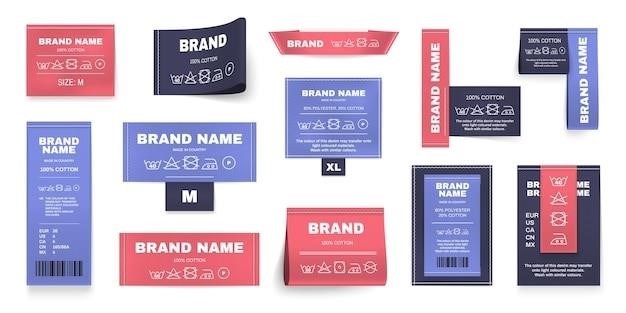Nike Tag Guide⁚ A Comprehensive Overview
This guide explores the evolution of Nike tags, from the simple designs of the 1970s and 80s to the sophisticated tags of today․ Learn to identify key tag elements, date vintage Nike clothing, and authenticate modern Nike products using barcodes and QR codes․ Discover regional variations and understand the importance of tags in verifying authenticity․
Early Nike Tags (1970s-1980s)
Early Nike tags from the 1970s and 80s were remarkably simple, often featuring just the Nike script logo, sometimes accompanied by the iconic swoosh․ The color palette was typically limited, with orange and white being prevalent choices․ These early tags lacked the intricate detail and vibrant colors that would characterize later decades․ The “Made in USA” designation was common, reflecting the brand’s initial domestic manufacturing focus․ Finding these early tags today is a testament to the enduring appeal of vintage Nike apparel․ Variations existed, but the overall aesthetic was consistent with a minimalist approach․ The simplicity of these tags stands in stark contrast to the more complex designs that emerged in subsequent years․
The Evolution of the Swoosh and Script
The Nike swoosh, initially a simple design, underwent a subtle yet significant evolution on its tags․ Early iterations were often paired with the wordmark “Nike” in a straightforward font․ Over time, the swoosh became more prominent, sometimes taking center stage on the tag․ The font used for the “Nike” script also evolved, transitioning through different styles, weights, and sizes․ These changes reflected broader design trends and Nike’s brand development․ The interplay between the swoosh and the script became a defining characteristic of Nike’s visual identity, visible across various tag designs․ The combination of these two elements, evolving in tandem, created a visual narrative that speaks to Nike’s history and brand evolution․ The careful observation of these changes can help in dating vintage Nike apparel․
Nike Tags of the 1990s⁚ Increased Detail and Vibrancy
Nike tags in the 1990s showcased a marked shift towards increased detail and vibrancy․ The simple designs of previous decades gave way to more complex layouts, incorporating a wider range of colors and fonts․ This reflected the era’s broader aesthetic trends, which emphasized bolder graphics and brighter hues․ Tags from this period often included more information, such as model names and size details, presented in a more visually engaging manner․ The incorporation of the Nike Air logo became increasingly common, signifying the brand’s prominent Air technology․ The overall aesthetic became more sophisticated, reflecting Nike’s growing market dominance and its evolving brand image․ These stylistic choices are key to identifying and authenticating vintage Nike apparel from the 1990s․

Authenticating Vintage Nike Apparel
This section focuses on verifying the authenticity of vintage Nike clothing․ We’ll explore key tag elements like color, font, and materials, providing a decade-by-decade guide to dating your vintage pieces and highlighting regional tag variations․
Identifying Key Tag Elements⁚ Color, Font, and Materials
Authenticating vintage Nike apparel hinges on carefully examining the tag’s details․ Color variations are crucial; early tags often featured simple orange and white, evolving to more vibrant palettes in later decades․ Font styles changed significantly over time․ Early tags might use a classic Nike script, while later ones incorporated bolder, more modern fonts․ Pay close attention to the materials used in the tag’s construction․ Early tags might be made of a thinner, less durable material compared to the sturdier tags found on later apparel․ The presence of a “Made in USA” or other country-of-origin label is also a key indicator for dating and authenticity․ Comparing your tag to known examples from the suspected era is essential for accurate authentication․ Subtle differences in stitching, thread color, and overall tag construction can help distinguish authentic pieces from counterfeits․ Remember, a holistic analysis of these elements provides the most reliable assessment of authenticity․
Dating Your Vintage Nike Clothing⁚ A Decade-by-Decade Guide
Accurately dating your vintage Nike clothing requires a keen eye for detail and a good understanding of the brand’s stylistic evolution․ The 1970s and 80s saw simpler tags, often featuring the Nike script and swoosh in basic color schemes․ The late 80s and 90s introduced more intricate designs, incorporating model names and bolder color combinations․ The 2000s brought increased sophistication, with technological advancements reflected in tag designs․ Look for subtle changes in font styles, logo variations (size, color, style of swoosh), and tag materials․ The presence of “Made in USA” or other country-of-origin markings can be highly informative․ Online resources, including forums and dedicated Nike collector sites, offer valuable comparative examples․ Consider factors like overall garment style and condition, as these can provide additional clues․ Remember, a combination of tag analysis and contextual clues delivers the most accurate dating assessment․
Regional Variations in Nike Tags (e․g․, Made in USA)
Nike’s global manufacturing footprint has resulted in significant variations in clothing tags across different regions․ The simple “Made in USA” label, prevalent in earlier decades, signifies garments produced domestically․ The shift towards global manufacturing introduced tags indicating production in countries like Indonesia, Vietnam, and China․ These regional variations aren’t solely limited to country-of-origin labels; subtle differences in tag design, materials, fonts, and even color palettes can exist between regions․ Understanding these variations is crucial for authentication․ For example, a tag from a specific era might feature a unique font or color scheme common only in a certain manufacturing location․ Collectors and enthusiasts often utilize these regional cues to distinguish genuine articles from counterfeits․ Researching specific regional tag variations during a particular era can significantly enhance the accuracy of authentication․

Modern Nike Tags and Authentication
Modern Nike tags utilize barcodes and QR codes for verification, enhancing product information and authenticity․ These features allow consumers to easily check the legitimacy of their Nike products and trace their origins․
Identifying Authentic Nike Tags in the 2000s and Beyond
Authenticating Nike products from the 2000s and beyond requires a keen eye for detail․ While the overall design aesthetic shifted towards a more minimalist approach, subtle variations in font styles, stitching quality, and material composition can reveal counterfeits․ Look for crisp, clear printing on the size tags, consistent stitching, and high-quality materials․ The presence of a clearly visible and correctly formatted barcode or QR code further enhances authenticity․ These codes, when scanned, should direct you to official Nike product information pages․ Compare your tag’s features to images of authentic tags found on reputable websites and forums dedicated to Nike collecting and authentication․ Pay close attention to the color accuracy of the swoosh logo and any accompanying text․ Any inconsistencies or blurry printing are strong indicators of a fake․ Remember, the details matter when it comes to verifying the authenticity of modern Nike products․
Utilizing Barcodes and QR Codes for Verification
In the 21st century, Nike has integrated barcodes and QR codes into its authentication strategy, providing consumers with a convenient way to verify the authenticity of their products․ These codes, often found on the product’s hang tag or size label, offer a quick and easy method to check the legitimacy of Nike apparel and footwear․ To utilize these features, simply download a barcode or QR code scanner app on your smartphone․ Scan the code on your Nike product․ A successful scan should redirect you to a Nike product page containing details about the specific item, such as its style number, colorway, and manufacturing information․ Discrepancies between the information displayed and the actual product you possess suggest a potential counterfeit․ If the code leads to an invalid or non-existent product page, or if the information is inconsistent, it strongly indicates that your item is not authentic․ This technological approach represents a significant step forward in Nike’s efforts to combat counterfeiting and safeguard consumer trust․